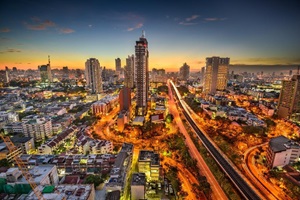- Intelligent Transportation Systems
- Transportation Efficiencies
- Conferences and Events
ITS Applications as a Key Element of the Smart City

Coauthored by Ryan Citron
As urban areas see increasingly ubiquitous connectivity, opportunities for intelligent transportation system (ITS) applications are growing. ITS is a mature market and is a standard part of public agencies’ planning and operations tool kits. However, with individuals now continually online through mobile devices and the advent of the Internet of Things (IoT), ITS applications are growing in complexity and sophistication. ITS applications are also being tied into the broader smart city movement, which includes all aspects of city services, such as energy, buildings, water, and waste management.
Consumer Expectations
Consumers of transportation services increasingly expect dynamic real-time information on and access to a range of mobility options. At the same time, cities and other transportation agencies want visibility into all aspects of the transportation landscape and the ability to respond in real-time. The increasing availability of real-time data on traffic and transit services is providing new tools to city managers for both operation optimization and new services to users. In Helsinki, for example, the bus service operator Helsingin Bussiliikenne Oy (HelB) worked with IT services company CGI to improve its competitiveness through the use of sensors and data analytics on service performance.
Observing ITS Applications
Guidehouse Insights’ recent report on the ITS market, Intelligent Transportation Systems, focuses on advanced ITS applications such as active traffic management, advanced traveler information services, and solutions that provide single access to a range of transportation modes.
While these types of services have the potential to provide significant benefits in improved mobility, reduced congestion, lower emissions from vehicle traffic, and optimized use of space within a city, most public agencies are still exploring how and at what pace they can incorporate advanced ITSs into their transportation systems. There are issues of cost, which can be significant, along with inadequate funding levels, complexity of data aggregation and analysis, and difficulty getting coordination across multiple agencies with responsibility for transportation and infrastructure. Cities that have led the way in adopting advanced ITS services can be useful guides to what works in different city environments.
Examples of City ITS Innovations
The Smart Cities Pavilion that will be open at the 2017 ITS World Congress is showcasing a handful of cities that have innovated in ITS applications like traffic management, transit services, and integrated mobility. The cities announced as exhibitors are Montreal, Canada (the ITS World Congress host city); Columbus, Ohio; Singapore; Copenhagen, Denmark; and Christchurch, New Zealand. The selection represents a wide range in terms of geography and population size/density from the ultra-dense Singapore with its population of around 5.6 million to the comparatively small city of Christchurch at under 400,000.
It should be interesting to see the similarities and the differences that come with these contrasting environments, as well as how they fit into the broader smart city activities underway in each locale. Event organizers have indicated that the smart cities pavilion will offer experiential exhibitions around the themes of Urban Mobility, Engaged Citizenry, Smart Security, Economic Cluster, and Smart Democracy. These themes go beyond transportation, placing ITS in the larger smart city context that cities are looking to implement.
I will be attending the 2017 ITS World Congress, being held this year in Montreal, from October 29 to November 2. The event features a large roster of speakers and exhibitors covering all aspects of ITSs. See the conference website for more details.